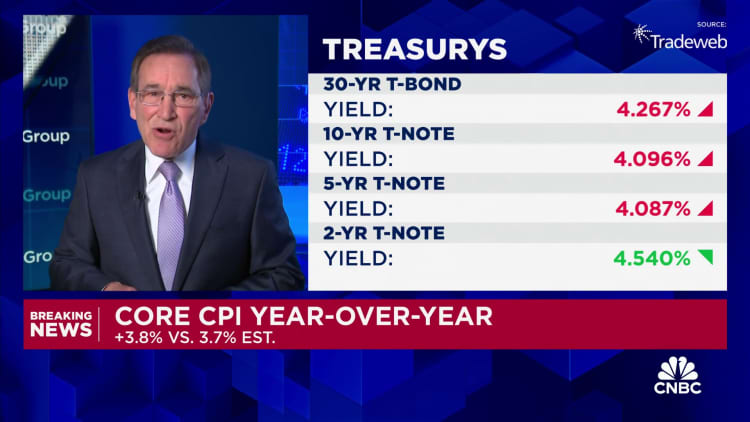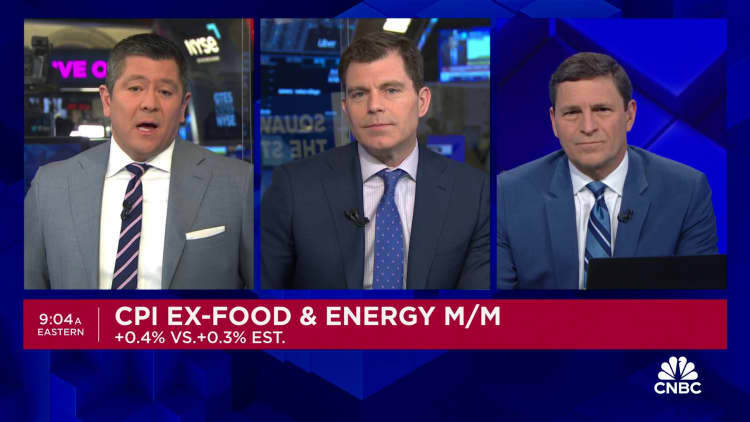Inflation rose again in February, keeping the Federal Reserve on course to wait at least until the summer before starting to lower interest rates.
The consumer price index, a broad measure of goods and services costs, increased 0.4% for the month and 3.2% from a year ago, the Labor Department’s Bureau of Labor Statistics reported Tuesday. The monthly gain was in line with expectations, but the annual rate was slightly ahead of the 3.1% forecast from the Dow Jones consensus.
Excluding volatile food and energy prices, the core CPI rose 0.4% on the month and was up 3.8% on the year. Both were one-tenth of a percentage point higher than forecast.
While the 12-month pace is off the inflation peak in mid-2022, it remains well above the Fed’s 2% goal as the central bank approaches its two-day policy meeting in a week.
A 2.3% increase in energy costs helped boost the headline inflation number. Food costs were flat on the month, while shelter rose another 0.4%.
The BLS reported that the increases in energy and shelter amounted to more than 60% of the total gain. Gasoline jumped 3.8% on the month while owners’ equivalent rent, a hypothetical gauge of what homeowners could get renting their properties, rose 0.4%.
“Inflation continues to churn above 3%, and once again shelter costs were the main villain. With home prices expected to rise this year and rents falling only slowly, the long-awaited fall in shelter prices isn’t coming to the rescue any time soon,” said Robert Frick, corporate economist at Navy Federal Credit Union. “Reports like January’s and February’s aren’t going to prompt the Fed to lower rates quickly.”
Fresh chicken breasts are displayed for sale in the meat area of a Sprouts Farmers Market grocery store in Redondo Beach, California on February 23, 2024.
Patrick T. Fallon | AFP | Getty Images
Airline fares posted a 3.6% increase, apparel prices rose 0.6% and used vehicles were up 0.5%. Medical care services, which helped feed a higher-than-expected CPI increase in January, decreased 0.1% last month.
The year-over-year increase for headline CPI was 0.1 percentage point higher than January, while core was one-tenth of a point lower.
Wall Street opened higher following the report, major stock averages as well as Treasury yields positive in early trading.
While the 12-month pace is off the inflation peak in mid-2022, it remains well above the Fed’s 2% goal as the central bank approaches its two-day policy meeting in a week.
Fed officials in recent weeks both have signaled that rate cuts are likely at some point this year and expressed caution about letting up too soon in the battle against high prices. The statement after the January meeting indicated that policymakers need “greater confidence” that inflation is moving back to target.
Chair Jerome Powell, in congressional testimony last week, echoed those concerns, though he did mention that the Fed is probably “not far” from the point where it can start easing up on monetary policy.
Tuesday’s report “leaves Fed officials some way from attaining the ‘greater confidence’ needed to begin cutting interest rates,” said Paul Ashworth, chief North America economist at Capital Economics.
For financial markets, the shift in the Fed stance from its apparent policy pivot in late 2023 has meant a repricing on the pace of rate cuts. Where futures traders entered the year expecting cuts to start coming in March, with six or seven total on the year, they have pushed out the first reduction to June, with two or three to follow, assuming cuts in quarter percentage point increments.
A bustling economy has helped the Fed focus on incoming data and allowed policymakers to avoid having to rush to lower rates. Gross domestic product expanded at a 2.5% annualized pace in 2023 and is on pace to increase at a 2.5% pace in the first quarter of 2024, according to the Atlanta Fed’s GDPNow tracker.
One key ingredient in that growth has been a resilient consumer boosted by a strong labor market. The economy added another 275,000 nonfarm jobs in February, though the increase skewed heavily to part-time positions and the unemployment rate rose to 3.9%.
Such strength can be a double-edged sword: While the growth in the face of aggressive rate hikes has bought the Fed time on policy, it also raises concerns that inflation could be more durable than expected.
Housing costs in particular have caused concern.
Shelter comprises about one-third of the CPI weighting and has been slow to decelerate, at least according to the BLS measure. Fed officials see rental prices coming down through the year, and other measures outside the CPI computation of owners-equivalent rent have shown easing price pressures.
Correction: The BLS reported that the increases in energy and shelter amounted to more than 60% of the total gain. An earlier version misstated a sector.

 Accounting1 week ago
Accounting1 week ago
 Personal Finance1 week ago
Personal Finance1 week ago
 Accounting1 week ago
Accounting1 week ago
 Finance1 week ago
Finance1 week ago
 Economics1 week ago
Economics1 week ago
 Personal Finance1 week ago
Personal Finance1 week ago
 Personal Finance1 week ago
Personal Finance1 week ago
 Blog Post1 week ago
Blog Post1 week ago
























